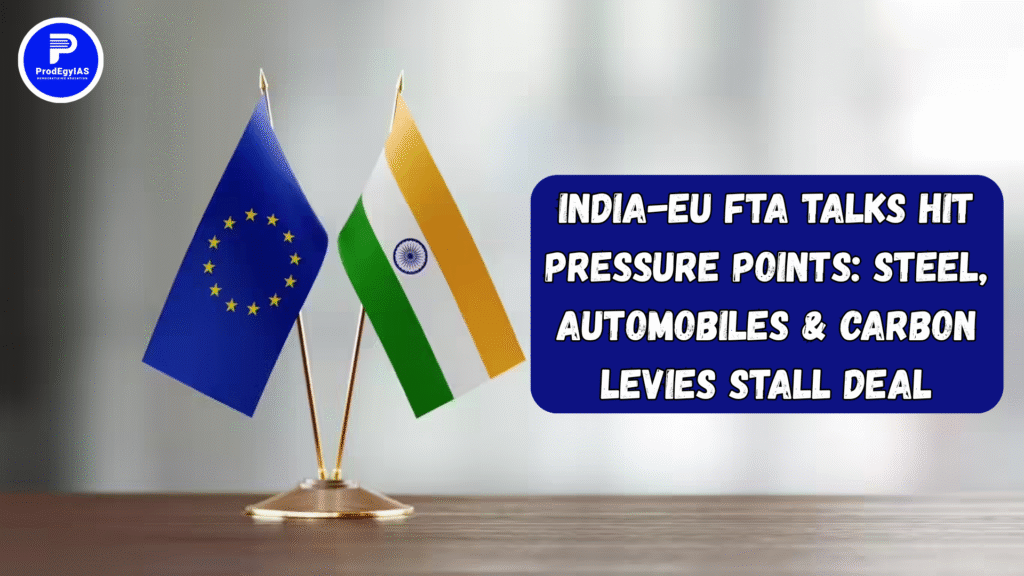
Introduction
Talks with the European Commission during India’s Commerce and Industry Minister Piyush Goyal’s recent visit to Brussels (October 26–28) showed that although both parties are still committed to signing a full free trade agreement (FTA) by the end of 2025, there are still a number of important issues. Industries including steel, autos, and the EU’s carbon border adjustment mechanism (CBAM) in particular stood out as intricate obstacles.
Why it is important
- In terms of goods, the EU is India’s biggest trading partner; in FY 2023–2024, bilateral commerce totalled over USD 137.5 billion.
- When the FTA is finalised, it may facilitate easier entry for foreign investment into India’s industrial and digital sectors and create significant new potential for Indian exports (textiles, leather, and services).
- Unresolved problems in high-stakes areas, however, point to a larger conflict: India’s desire to safeguard its own industry against the move in global trade standards towards stricter regulations and carbon accountability.
- Future trade agreements between India and other significant blocs will be influenced by how these discussions manage carbon levies and regulatory harmonisation.
Important Advancements & Unresolved Concerns
- In the Brussels conference, India and the EU agreed to expedite the process of determining “non-sensitive industrial tariff lines” while exploring “possible landing zones” for a number of tariff and regulatory items.
- While the EU expressed worries about India’s export competitiveness in carbon-intensive items, India pushed for preferential access for labour-intensive industries like leather and textiles.
- Given its industrial structure, India sees the CBAM, which would put tariffs on high-carbon commodities entering Europe starting in 2026, as a potential trade obstacle.
- Next week, a technical team from the EU is anticipated to travel to India in order to progress in-depth talks and resolve the more controversial regulatory matters.
Difficulties and Strategic Aspects
- India must balance upholding its protective posture for emerging businesses with conforming to international standards that increasingly value high quality, low-carbon production, and open regulations.
- Due to their size, energy requirements, international rivalry, and the recent introduction of carbon taxes, the steel and automotive industries are particularly vulnerable.
- External trade pressures will put India’s internal reforms (in manufacturing, decarbonisation, and regulatory alignment) to the test.
- Geopolitical factors are important; the agreement signals India’s industrial policy, trade orientation, and place in the Indo-Pacific and global value chains, among other strategic considerations
Way forward
- To ensure that Indian businesses are ready rather than exposed when trade regulations change, India should create a verified plan for bringing its industrial sectors—such as steel, automobiles, and chemicals—in line with low-carbon norms and transparency.
- To turn trade negotiating pressure into an opportunity for industrial upgrade, the government and business should expedite domestic reforms, such as increasing digital traceability, lowering carbon intensity, and strengthening manufacturing competitiveness.
- In order to safeguard India’s development aspirations, negotiators must aim for balanced results, securing market access for labour-intensive Indian exports while pledging to create easy paths for carbon-sensitive items.
- Public communication is essential. By properly explaining to citizens and business the advantages of a free trade agreement (FTA), the trade-offs involved, and the necessary medium-term transitions, industry readiness and domestic consensus will be increased.
An important turning point has been reached with the recent India-EU negotiations. Although it is ambitious and desirable to complete the FTA by the end of 2025, economic diplomacy and domestic policy reform must be closely coordinated due to the intricate interactions between trade liberalisation, regulatory harmonisation, and carbon accountability. The pact could unlock significant development and strategic benefits if India manages this moment properly; but, a misalignment or delay could impede global trade partnerships and industrial competitiveness.
UPSC General Studies Paper Preparation
| Topic | |
| UPSC Syllabus | UPSC Free Notes |
| UPSC Optional Subjects | Khushhali Solanki (AIR 61, UPSC CSE 2023) |
Public Administration Optional Exam Preparation
Topic | |
About the Author: Jyoti Verma



